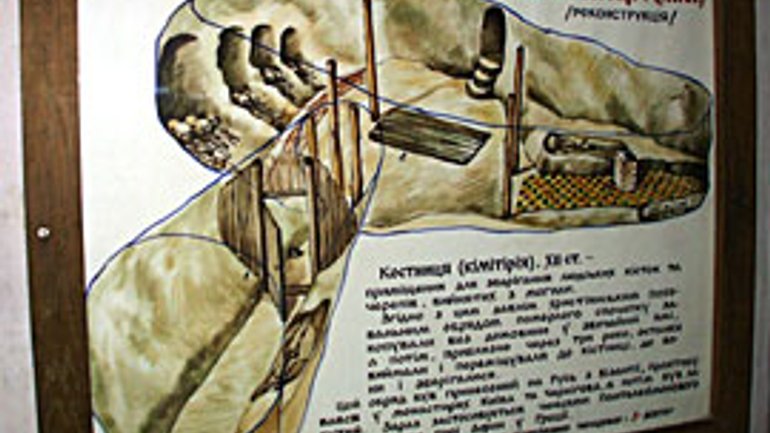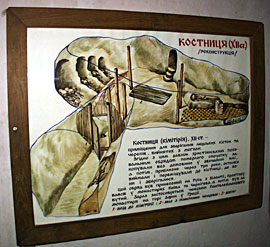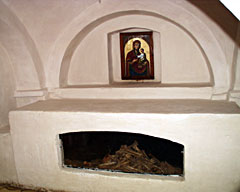Mysteries and Legends of the Cave Monastery in Chernihiv

 Archaeologists hope that the 15 caves that have been studied will be followed by others, especially the fortification caves. However, no matter how many caves are discovered, the most famous have been and will remain Anthony's Caves of the Trinity-St. Elias Monastery, which is now part of the Chernihiv national architectural and historical park "ancient Chernihiv."
Archaeologists hope that the 15 caves that have been studied will be followed by others, especially the fortification caves. However, no matter how many caves are discovered, the most famous have been and will remain Anthony's Caves of the Trinity-St. Elias Monastery, which is now part of the Chernihiv national architectural and historical park "ancient Chernihiv."
By the way, during the last decade official representatives of the Ukrainian Orthodox Church-Moscow Patriarchate (UOC-MP) have repeatedly expressed their wish to take Anthony's Caves under their trusteeship (apparently for the purpose of establishing something similar to the Kyivan Monastery of the Caves). However, the issue still remains undecided, since this monument is included in the list of religious buildings that are not to be given to religious communities.
The idea that life in caves is associated only with our distant, uneducated ancestors is not absolutely correct, especially in view of the comparatively recent historical events of the beginning of the 20th century.
Priest-monk Alipii (secular name: Oleksandr Yakovenko) of the Trinity Monastery was an outstanding man, combining in himself a strong gift for organizing, a bold character, dignity and an absolute rejection of Soviet authority. These qualities turned the salesman Yakovenko into the self-canonized priest-monk Alipii. He was later convicted because of his beliefs. Then he went underground and became loyal to the Nazi regime as a result. Only his accidental death from a German shell in 1943 saved him from another Soviet sentence, which most probably would have been more severe.
If this man had not become the founder of the last underground cloister in the history of Chernihiv cave-building, his name most probably would have been lost in time, as has been the case with many equally outstanding persons. Today the cloister bears his name.
In the spring of 1918, some of the residents of Chernihiv knew that a group of people headed by Priest-Monk Alipii were digging a cave near the fence of Trinity-St. Elias Monastery, in a deep overgrown ravine out of sight, for to do so otherwise was dangerous at the time of the Revolution. It was not an easy period for the church: a schism began to develop even among the monks. Therefore, it was necessary to take measures to strengthen the authority of Orthodoxy. These endeavors were manifested in extreme forms of religious asceticism, including cave monasticism.
It is known that the majority of the workforce involved in digging the cave consisted of monks, nuns and also sympathetic townsmen, even including Evangelical Christians. According to testimonies (in 1975) of eye-witnesses of these events, the big underground chambers were dug in an unusual way, without any equipment and tools other than ordinary spades, picks, and bags for transporting the earth.
First of all, they dug a sloping gallery up to the level of the top of the vault, and then dug downwards. This allowed them to build an underground cave of any height without the use of ladders and scaffolding.
 The complex of caves (a complicated maze in the shape of a figure 8) built by Alipii was richly decorated by bright wall paintings, clay-carvings on the walls and arches, and iconographic compositions. The decorations were made by Alipii himself, two young nuns, and a monk who also painted icons. There was a chapel in the center of a newly-built complex, which collapsed after the war as the result of the activities of some young treasure-seekers. The new monastery was dedicated in 1919, but soon ceased to exist. The fate of its irrepressible founder was also tragic. A German shell directly hit a nearby church, while the priest, Alipii, and his parishioners were inside.
The complex of caves (a complicated maze in the shape of a figure 8) built by Alipii was richly decorated by bright wall paintings, clay-carvings on the walls and arches, and iconographic compositions. The decorations were made by Alipii himself, two young nuns, and a monk who also painted icons. There was a chapel in the center of a newly-built complex, which collapsed after the war as the result of the activities of some young treasure-seekers. The new monastery was dedicated in 1919, but soon ceased to exist. The fate of its irrepressible founder was also tragic. A German shell directly hit a nearby church, while the priest, Alipii, and his parishioners were inside.
Having suffered numerous calamities, Alipii's Caves are currently in very poor condition.
Sad times in Chernihiv
The former metropolitan of Moscow, Tikhon (Basil Bellavin), who was elected patriarch of the Orthodox Church in 1917, did not bring peace to the souls and minds of his fellow countrymen stirred by the Revolution. He adopted a position of absolute non-acceptance of the existing authority. The confrontation between the church and the Soviet authority soon reached its climax. In 1923 Tikhon was reduced to the position of a layman during the Second All-Russian National Sobor. The open resistance was dealt with, but it did not bring peace. The confrontation between the two ideologies, Christian and communist, had a tragic affect not only on people's lives but also on monuments of spiritual culture.
This bitter cup did not pass from Chernihiv's Trinity-St. Elias Monastery, either. In 1920 it was closed down, and the Trinity Cathedral community was established in its stead. Priest-monk Smarahd (Samson Chernetskyi) was appointed archpriest. He adhered strictly to Tikhon's standpoint.
The newly established community was actively supported by the then-well-known Black Hundred publicist (the author of a literary fake, The Protocols of the Elders of Zion) Sergei Nilus, who lived in Chernihiv from 1925 to 1927. He was an activist of a local religious community "Tikhon's followers," supported persecuted priests, and won over to his side the Chernihiv bishop, Parkhomii, and the odious Alipii (who were later arrested). Trinity Cathedral was closed down in 1929.
At that time of troubles, Luka Proskura, who had the post of psalm reader, became "spiritual father of Chernihiv monks." He was canonized as Saint Lavrentii in the 1950s. His name is associated with one of the less known caves accidentally discovered in 1970. The cave was called "Western" (because of its location to the west of Anthony's caves). It was probably the religious center of a secret monastic community after the closing of Trinity Cathedral and existed until after the war.
This cave is situated in a natural boundary, the Maliiv Trench (85 meters to the south of the fence of the Trinity Monastery). The entrance is about 2 meters high, the galleries have no supports. The underground church of 30 square meters is 7 meters high. The cell of Lavrentii himself is probably also in the cave.
The total length of tunnels explored in the western cave is 40 meters. However, the size of the monument is undoubtedly much bigger, which is indicated by numerous blockages. Two more caves were discovered in the area during the last decade: "The Cave in the shape of the [Ukrainian] letter ?" and "The Grotto." They also date from the first half of the last century. The 1300-year history of Chernihiv is inseparably linked with the cave monasteries and their outstanding dwellers. Archaeologists, architects, students of local lore and painters are convinced that it is impossible to understand and get the feel of this ancient town without the caves.
The first cave monastery
"Trinity-St. Elias Monastery, the place of residence of Chernihiv archbishops, is situated on the Boldyni Mountains and at first sight resembles the Kyivan Monastery of the Caves," wrote church figure and historian Chernihiv Archbishop Filaret (Humilevskyi) about one of the most ancient monasteries of Rus more than a hundred years ago.
One night in 1069 a monk who was famous and respected in the whole of Rus came to Chernihiv. St. Anthony, the "father of monasticism in Rus," born in the village of Liubech near Chernihiv, left the capital not of his own will but fleeing the wrath of the grand prince of Kyiv, Iziaslav Yaroslavych. For Anthony had dared not to be on the prince's side, but on the side of the people of Kyiv during a rebellion in that city.
Grand Prince Sviatoslav Yaroslavych of Chernihiv actively supported Anthony's idea of establishing a cave monastery of the Mother of God near Chernihiv.
The monastery was not to be inferior to the Kyivan Monastery of the Caves, as Chernihiv strongly competed with Kyiv in all fields of development at that time. Therefore, it was also situated outside the town walls in a natural boundary covered with legends. The ravine chosen by Anthony for the caves led to a holy natural boundary, where, according to legend, the people of Chernihiv had been baptized, and it adjoined a massive pagan burial mound. It was a place venerated from ancient times.
In scholarly terms, the Chernihiv caves are man-made underground buildings dug in different periods in the thick layer of the right main bank of the Desna river . They stretch for more than 4 kilometers to the southwest of an ancient settlement, Dytynets, on hills separated by deep ravines with steep slopes covered with thick vegetation dominated by oaks. These are remnants of ancient forests, from which the area's name, the Boldyni Mountains, is derived ("bold" is ancient Rusyn for "oak").
Built after the pattern of ancient Orthodox monasteries (Anthony lived on Mount Athos for a time), the monastery was an underground town. Anthony's Caves, as they are known now, are only part of the cave complex. It is safe to say that today there are seven known underground caves of the period of ancient Rus in this area, and there is no doubt there were many more.
Recent research shows that the idea that the caves were long, tangled mazes was wrong. It is clear now that the design of the underground buildings was rational, and that the monastery also had surface buildings. St. Elias Church is the only building that still survives. It is the only ancient Rusyn pillarless church with a cross-shaped dome. Not long ago traces of ancient brick production were discovered in the territory of the monastery, indicating that not all the surface buildings were wooden.
In 1072 (after three years in Chernihiv), Anthony returned to Kyiv, and the monastery established by him continued to develop. Unfortunately, there is no information about the Monastery of Our Lady's land holdings in the pre-mongolian period. However, we can assume that part of the villages owned by it in the 17th and 18th Centuries had been its property in the early Middle Ages, also.
Dark age and Renaissance
 On 18 October 1239, Khan Batyi's army captured Chernihiv and destroyed it. The chronicles provide no details. However, it is evident that the monastery was in decline, though the fact, that St. Elias Church still survives refutes the idea of its complete destruction. Archaeological data indicate that in the 13th to 15th centuries there was still a glimmer of life there. The absence of any written evidence before 1649, when the monastery was revived, does not prove that it was neglected for 400 years. Rather it is an indication of the enemy raids and fires suffered by Chernihiv, in which manuscripts are usually destroyed.
On 18 October 1239, Khan Batyi's army captured Chernihiv and destroyed it. The chronicles provide no details. However, it is evident that the monastery was in decline, though the fact, that St. Elias Church still survives refutes the idea of its complete destruction. Archaeological data indicate that in the 13th to 15th centuries there was still a glimmer of life there. The absence of any written evidence before 1649, when the monastery was revived, does not prove that it was neglected for 400 years. Rather it is an indication of the enemy raids and fires suffered by Chernihiv, in which manuscripts are usually destroyed.
The beginning of the Renaissance in Ukraine at the start of the 17th Century was also the start of a new life for the Chernihiv monastery. After the liberation of the town from Polish domination in 1649, the ancient cloister was revived thanks to the efforts of a senior centurion of Chernihiv's Cossack regiment, Stepan Podobailo. and Priest-monk Zosyma Tyshevych. Since that time it has been called St. Elias. During archaeological excavations of the last decade, so-called "Anthonian" caves were discovered and studied. They were probably dug in the 17th century.
The powers that be, the Muscovite King Oleksii Mykhailovych and Hetman Ivan Skoropadskyi, were involved in extending the monastery's property. In the 18th century its economy included 9024 serfs of both genders. The monastery also owned 26 groves, 16 lakes, 30 mills, 31 glass, paper, metal and food producing facilities.
All this made it possible to built and dedicate the big and very magnificent Trinity Cathedral in Chernihiv in 1695. After they had moved to new comfortable cells, the monks forgot the caves for some time. However, they were not forgotten forever, as further events show.
At that time only fanatical recluses lived there. Church authorities planned to turn the caves into a center of religious pilgrimage, a special religious museum, as the wonder-working icon of the St. Elias Mother of God was already famous for its miracles. The caves themselves were sanctified by the name of the venerable Anthony: they included the so-called "Anthony's Cell." To top it all, the monastery gave birth to a legend of martyr-monks killed by Mongol-Tatars in the year 1239, tragic for Chernihiv. The legend said that their bones were kept in an open sepulcher at the Church of St. Nicholas the Wonder-worker.
According to written sources, the caves were used also for healing "possessed" people; that is to say, they were successfully used as a lunatic asylum, as healing by silence and darkness had been practiced for a long time.
The reconstruction of the caves near St. Elias Church lasted for more than a century: unused old monastic caves were destroyed, and the underground churches and chapels were "clothed" in brickwork. Anthony's Caves took their final shape at the end of the 19th century. And at the end of the 20th century they were supplemented with a lower level of caves, that had been separate from the main complex before, and an ancient Rusyn chapel and "cemetery," where the skulls and bones of dead monks were kept. This was a very rare situation, in view of the fact that the monastic burial rite of Mt. Athos never took root in Rus. The rite was practiced only in two cave monasteries: in Kyiv and Chernihiv.
The size of the underground buildings also speaks about the immensity and uniqueness of Anthony's Caves. For example, the parameters of the Church of St. Anthony Pecherskyi ("of the caves") are 11.7 ? 4 meters, and the height of the Church of Feodosii Totemskyi is 8.4 meters, which is nearly the height of a 3-storey building.
Ghosts of Anthony's Caves
At first it is hard to believe in this phenomenon. However, there are facts that cannot be dismissed as products of the imagination, no matter how much we would like it to be so.
Information about paranormal phenomena in the caves has intrigued more than one generation of researchers from various towns in Ukraine and even abroad. "Wonders were first observed over thirty years ago, when we, members of the town speleological section, started to study this unique underground monument," says Volodymyr Rudenok, a professional archaeologist with years of experience in individual excavation, the head of the Caves Department of Chernihiv architectural-historical national park "ancient Chernihiv."
 "Even at the beginning stages of the work my colleagues and I began to notice some mysterious phenomena," notes Rudenok. "Sometimes we could hear a sound in absolute silence or smell incense. At other times we had a feeling that someone was standing and breathing right behind our backs (this feeling was the most difficult to explain). It could not be explained by fear, as all of us already had solid experience of work not only in Anthony's Caves, but also in many kilometers long labyrinthine mazes in western Ukraine and Crimea. Therefore, we were seeking an earthly explanation of these strange phenomena, not disregarding even the possible existence of some sort of a religious cave sect. For, despite the authorities' prohibition, the tradition of religious cave-dwelling was still alive in Chernihiv as recently as the 1950s, which was 20 years earlier.
"Even at the beginning stages of the work my colleagues and I began to notice some mysterious phenomena," notes Rudenok. "Sometimes we could hear a sound in absolute silence or smell incense. At other times we had a feeling that someone was standing and breathing right behind our backs (this feeling was the most difficult to explain). It could not be explained by fear, as all of us already had solid experience of work not only in Anthony's Caves, but also in many kilometers long labyrinthine mazes in western Ukraine and Crimea. Therefore, we were seeking an earthly explanation of these strange phenomena, not disregarding even the possible existence of some sort of a religious cave sect. For, despite the authorities' prohibition, the tradition of religious cave-dwelling was still alive in Chernihiv as recently as the 1950s, which was 20 years earlier.
"However, what happened on 7 February 1970 made me change my view of these phenomena. At the time we were working at the lower level of the complex. We dug by candle and lantern light, as the outside door was locked and there was no electricity in the caves. When the light went out, I went to get the extra candles, which I kept behind the altar of Church of St. Mykola Sviatosha. As I walked in absolute darkness I saw something that was impossible: a man in long, dark clothes stood near Anthony's cell. I thought it was a hallucination and felt nervous. However, I hurried to bring the candles. To my great astonishment, they were not in their usual place... I had to return in absolute darkness again. On my way back I saw the same man in the same place once more. Everything was very real, except one thing: it was impossible to see anyone in absolute darkness.
"My later official position allowed me to analyze the behaviour of visitors of the caves. As a result of long observation I became convinced that people are affected by some unknown forces in the caves: for some, excitement suddenly changed into depression, for others it was vice versa; some had a headache, others felt a relief from heart pains.
"I remember an unsuccessfull attempt to use electric-magnetic instruments in order to find unknown caves near those already studied. Professionals installed probes and laid cables all over the complex and probed every centimeter of the walls, floors and vaults. They detected a number of anomalies there. The most pronounced of them was detected in a gallery leading from St. Mykola Sviatosha Church deeper inside the mountain. According to the experts' predictions, it should have been hollow. We eagerly anticipated success and a new discovery. However, laboratory analysis of the results was disappointing: it showed that there was no scientific explanation of these results... We had to be content with the hypothesis that there was a powerful anomaly in the part of Boldyni Mountains where Saint Anthony had established the monastery. And this seems logical, as in the old days they chose areas with extra strong energy fields for monasteries and churches, where people would feel the effect of inexplicable natural factors.
"I did everything within my power to involve professionals of various branches of science once more (including geophysicists from Dnipropetrovsk) in order to solve the puzzle and obtained a result. All the researchers agreed that Anthony's Caves had an effect upon people and that it was strongest in the Church of St. Mykola Sviatosha. (Before taking monastic vows, he was King Sviatoslav of Lutsk, son of King David of Chernihiv, whose mortal remains are kept in the Kyivan Monastery of the Caves.)
"The wonders did not stop after the research. For example, several members of the museum staff saw a figure above one of the tombs in the gallery near St. Mykola Sviatosha Church. After it had disappeared they could still see gaseous luminiscence for quite some time.
"The events most interesting to me took place in the summer of 1995, when archaeological work was under way in the museum territory and there were many staff members, history students and curious visitors there. When I came to work they all stood at the entrance to the cave enthusiastically discussing the latest news of a monk roaming the galleries. He never came out, though nearly everyone had seen him. We conducted a search of the cave, but all in vain. In the same year, on August 16 and 23, about 3 p.m. a thick fog appeared in a blindway near St. Mykola Sviatosha Church, in which the figure of a monk was visible, sometimes with a bearded face, sometimes other shapes were visible. The vision stayed for about one and a half hours. Many people observed it; a painter, Volodymyr Zinchenko, even made drawings of it, and others tried to photograph it. It disappeared, leaving a gaseous, glowing trace.
What conclusion can we draw from this? None so far. We can just hope that one day the puzzle of Anthony's Caves will be solved.
Chernihiv- February 2003









